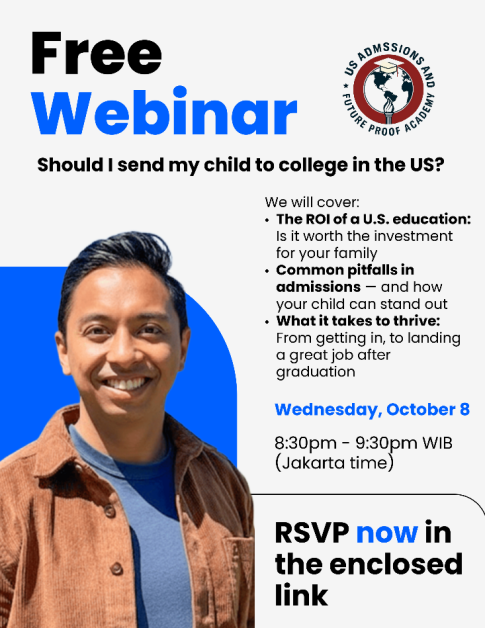Is a U.S. Education Still Worth It for Your Child? by Sanchit Ladha
Here’s what you need to know before applying
For decades, a U.S. college education has been the ultimate ticket to success—a pathway to prestigious degrees, high-paying jobs, and global opportunities. But in 2025, as tuition costs soar, visa policies tighten, and the job market becomes increasingly competitive, many of you might be asking the question: Is it still worth it?
The answer isn’t as simple as it used to be. For some students, the U.S. remains the best place to launch their careers. For others, the investment may not pay off. The key is to understand the factors that determine success—and to avoid common pitfalls that derail so many students.
Factors to consider
Return on investment
A U.S. degree is expensive – between $250K and $400K over four years – but if done right, it pays off. Top grads in fields like tech, law, medicine, consulting & finance earn more than anywhere in the world (after tax and purchasing power parity), and many build enough wealth in just a 20-year career to retire early or return home comfortably.
Career growth
Corporate America is more meritocratic than anywhere in the world, and Indians have the right temperament to succeed here. Indian-Americans are 1% of US population but hold over 10% of Fortune 500 CEO positions (some examples are Satya Nadella, Microsoft CEO, Sundar Pichai, Google CEO, Arvind Krishna, IBM CEO, Shantanu Narayen, Adobe CEO), and frequently make it to Executive level positions.
Undergrad vs. Masters – and Work Visas
There is legislation in the works for the H1-B visa system to favor higher salaries:
- Good news: There’s a minimum salary requirement of $80,000/yearto be considered, which filters out competition with non-college educated immigrants
- But in reality: Most H1-B spots will go to people earning $110K or more – which means it’s tough to get one right after undergrad, unless you land a top-paying job
So what should students do:
- Undergrad is best for top students in STEM majors (like Computer Science, Engineering, Math, Physics, Chemistry, Biology). These degrees come with 3 years of work authorization (called STEM OPT), giving time to gain experience and guarantee an H1-B visa after salary crosses $110K
- Master’s degrees are the safer bet – grads often start at $130K+ giving them a near-certain chance at the H1-B
Common Pitfalls
Even for families who decide to pursue a U.S. education, success is far from guaranteed. Here’s what I see as the two major reasons why the Investment doesn’t pay off:
Falling short in the admissions process
Many students end up at Tier 2 colleges – ones where top employers who sponsor work visa don’t recruit from.
Why: Admission to top US colleges requires more than grades and test scores. They are looking for a rounded individual, who demonstrates leadership, creativity, and has a cohesive narrative that that ties a student’s passions to their future goals. This should come across as genuine and not forced or “manufactured”.
Bottom line: Getting into a top school is critical — and it takes more than just academics and top test scores.
Struggling to find jobs after graduation
Even with a good degree, students can struggle to find jobs and end up returning home without U.S. work experience – despite a six-figure education.
Why: Many don’t understand what U.S. employers are really looking for – practical skills, relevant internships, and fit during interviews. It is often too late by the time they truly find out.
Bottom line: You need a clear career plan before you even step foot in college, and you must build toward it every semester in college.
Setting children up for success
The good news is that with the right planning, the common pitfalls are avoidable. Here’s what really makes a difference:
- Craft a strong narrative: Top colleges look for more than strong grades. Your child’s application should connect academics, activities, and future goals into one compelling narrative, which requires deep reflection
- Have career clarity: Know what types of roles and companies sponsor work visas, and deeply understand what the best fit might be based on your child’s interests. Start college with a clear plan – one main career path and a solid backup – especially in fields that offer better visa and salary outcomes
- Build necessary soft skills early: Soft skills, confidence, and career readiness don’t magically appear during college. The earlier your child starts developing them, the better prepared they’ll be to land a job after graduation
 RSVP for my free webinar: “Should I send my child to college in the US?”
RSVP for my free webinar: “Should I send my child to college in the US?”
RSVP link: https://forms.gle/L8Ma4oGASaXF9u4E8
About Me
My name is Sanchit Ladha and I was born in India, grew up in Indonesia. I came to the US for college in 2008, studying Electrical Engineering at Georgia Tech. Graduating in the aftermath of the Financial Crisis, jobs were difficult to come by but I took on leadership roles in college, secured internships, and cracked the interview process to land my dream job as a Strategy Consultant at Deloitte after graduation.
I have been on a 17-year journey in the US, navigating all kinds of interviews and visa hurdles. Along the way, I earned my MBA from Columbia Business School, worked in Private Equity, and held roles at prestigious institutions like McKinsey & Company in New York. Now, I lead Adobe’s in-house Incubator, where I develop cutting-edge Generative AI products that are shaping the future of technology.
Today, as someone who has recruited and evaluated hundreds of candidates – both fresh graduates and seasoned professionals – I have developed a sharp eye for what makes a candidate stand out and where most fall short. Now, I’m passionate about giving back to the community that shaped me. I will share the insights, strategies, and lessons I’ve learned to help the next generation of students and families navigate their own journeys with confidence and clarity.






